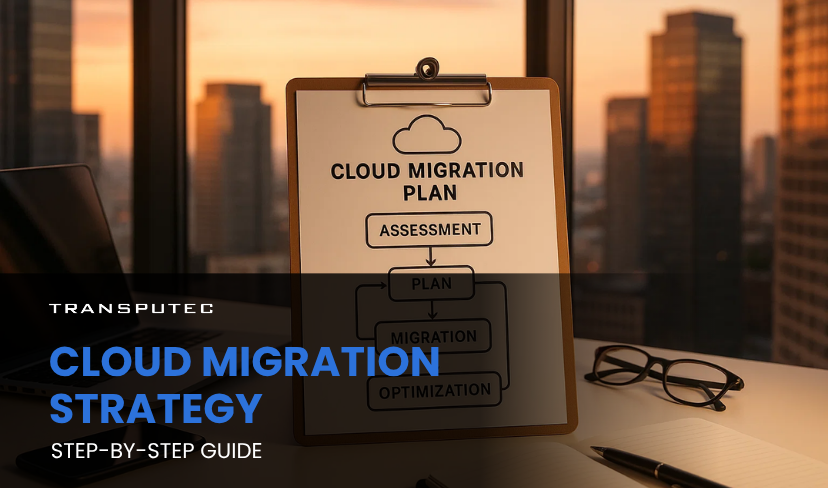Written by KRITIKA SINHA | MARKETING
Departments stuck with slow, outdated systems. Employees juggling patchy remote access. IT managers buried under maintenance tasks rather than innovation. These are not isolated problems. They’re symptoms of poor cloud planning.
A Cloud Migration Strategy isn’t just about moving data. It’s about minimising disruption, maintaining compliance, and setting up long-term efficiency. Without a structured plan, businesses risk data loss, extended downtime, and spiraling costs.
This blog will break down what a strong Cloud Migration Strategy looks like—step-by-step. You’ll learn how to evaluate your current infrastructure, plan for a secure and stable migration, choose the right partners, and understand how Transputec supports enterprise-grade migrations with real-world expertise.
What is a Cloud Migration Strategy?
A Cloud Migration Strategy is a structured plan that guides how an organisation moves its digital assets, services, and applications from on-premises infrastructure to the cloud. It isn’t just a tech upgrade, it involves deep analysis of business goals, security needs, and operational processes.
According to a 2024 report by Gartner, 75% of large organisations that lacked a formal migration plan experienced unexpected downtime and security vulnerabilities during their transition. Businesses that followed a structured cloud migration plan, however, saw an average of a 30% reduction in infrastructure costs within the first year.
Why Enterprises Need a Defined Cloud Migration Strategy?
A successful Cloud Migration Strategy addresses both technical and business challenges. Common problems solved include:
- Legacy system bottlenecks
- Rising maintenance costs
- Lack of scalability
- Cybersecurity threats
Having a plan helps align technical migration with business goals. It ensures that your team is prepared for changes in operations, compliance, and service delivery. Without a defined strategy, cloud migration projects are more likely to overrun their budgets and timelines.
Transputec brings decades of experience to help enterprises avoid these pitfalls through proven processes and hands-on support.
Ready to Secure Your Cloud with Confidence?
Connect with us today for our free consultation!
Step-by-Step Cloud Migration Strategy
Step 1 – Assess Your Current IT Environment
The first step in a successful Cloud Migration Strategy is a full audit of your existing infrastructure. This includes:
- Servers, applications, and data locations
- Security configurations
- User access patterns
- Compliance requirements
Tools like AWS Migration Evaluator or Azure Migrate can automate part of this process. But the real insight comes from IT leaders understanding their current pain points and performance metrics.
Transputec helps clients conduct thorough assessments, identifying what to keep, retire, or refactor before any move begins.
Step 2 – Define Business Objectives
Migration should never be a technical project alone. Your Cloud Migration Strategy should support specific business goals. These might include:
- Reducing capital expenditure
- Improving application performance
- Enabling remote work
- Preparing for data-driven operations
Transputec works directly with business leaders to align migration efforts with outcomes that matter to them—such as shorter time to market or compliance with sector-specific regulations like GDPR or HIPAA.
Step 3 – Choose the Right Cloud Model and Provider
Public, private, hybrid, or multi-cloud? Your Cloud Migration Strategy should define which model makes the most sense based on workload types, budget, and compliance demands.
Consider the following:
- Public cloud for cost efficiency and scalability
- Private cloud for strict data control
- Hybrid or multi-cloud for flexibility and risk management
Choosing between AWS, Azure, Google Cloud, or another provider should also come down to integration needs and technical support. Transputec assists in vendor evaluation and setup, ensuring compatibility and cost control from day one.
Step 4 – Plan the Migration Phases
A good Cloud Migration Strategy divides the move into manageable phases. Trying to migrate everything at once can be risky and disruptive. Phases might include:
- Pilot migration: Test with non-critical systems
- Priority workloads: Migrate apps with high business value
- Secondary systems: Move remaining assets in stages
This phased approach lowers risk and gives your team a chance to adjust before a full rollout. Transputec supports phased migrations with project management, continuous monitoring, and technical remediation where needed.
Step 5 – Data Security and Compliance Planning
Cybersecurity is often the most sensitive part of any Cloud Migration Strategy. A breach during transition can be disastrous. Your plan should include:
- Data encryption during transfer and at rest
- Role-based access control
- Security logging and monitoring
- Backup and recovery procedures
- Compliance with industry-specific laws
Transputec implements end-to-end encryption, identity management, and real-time monitoring to maintain compliance and protect data during and after migration.
Step 6 – Test, Monitor, and Validate
Before declaring the migration complete, everything must be tested: connectivity, performance, data integrity, and user access. This final stage in a Cloud Migration Strategy involves
- Functional and performance testing
- Security audits
- User acceptance testing (UAT)
- Monitoring dashboards setup
Transputec offers detailed reporting and analytics so enterprises can validate success and fine-tune their cloud environments based on real data.
Common Mistakes to Avoid in Your Cloud Migration Strategy
Even with a plan, missteps can happen. Here are some frequent errors to watch for:
- Skipping the assessment phase
- Not setting clear success metrics
- Failing to involve business units
- Overestimating in-house capabilities
- Ignoring training and user adoption
Each of these can derail your migration. A good Cloud Migration Strategy includes accountability at every stage. Transputec’s team helps identify blind spots and build contingency plans.
How Transputec Supports Your Cloud Migration Strategy?
Transputec offers a full-service approach to cloud migration that goes beyond simply moving your data. We partner with enterprises to reduce risk, save costs, and deliver a secure and smooth transition to the cloud. Here’s a detailed look at how we help:
1. Detailed Pre-Migration Assessments
Before any migration begins, Transputec conducts a deep audit of your existing IT infrastructure. This step is essential because it identifies system dependencies, application performance issues, security gaps, and redundant assets. During the assessment, we:
- Map out your current workloads and environments
- Evaluate which applications are ready for migration and which need re-architecting
- Identify compliance and data residency requirements
- Help define clear goals and performance expectations for the move
By thoroughly assessing your environment first, we reduce unexpected problems during migration and build a strategy that aligns with your business priorities.
2. Vendor and Platform Selection Assistance
Choosing the right cloud platform is not always straightforward. Each provider, whether AWS, Azure, or a private solution, has its own strengths and pricing models. Transputec guides you through:
- Comparing service offerings based on your specific workloads
- Cost analysis and forecasting across different platforms
- Vendor contract negotiation support
- Ensuring compatibility with your existing systems and long-term goals
We take an objective, needs-based approach to help you avoid unnecessary spending and ensure scalability and security in your cloud environment.
3. Ongoing Technical Support Post-Migration
The work doesn’t end once the migration is complete. New systems can create unexpected issues or require configuration updates as your business evolves. Transputec provides:
- 24/7 monitoring of cloud performance and uptime
- Rapid response support for any operational issues
- Regular system reviews to ensure efficiency and cost control
- Help desk support for internal teams adjusting to new tools or processes
This continuous support allows your internal IT staff to focus on innovation instead of being bogged down with troubleshooting and system management.
4. Security, Compliance, and Performance Optimisation
Security and compliance are non-negotiable, especially in industries with strict regulatory requirements. Transputec builds robust security measures into your Cloud Migration Strategy from the outset. We offer:
- Advanced threat detection and monitoring
- Role-based access control and identity management
- Data encryption during migration and in the cloud
- Regular compliance checks with industry standards (e.g., GDPR, HIPAA)
- Performance tuning to ensure optimal response times and resource usage
Our aim is to ensure your cloud infrastructure is not only functional but also resilient and compliant from day one.
With these services, Transputec becomes more than just a migration partner, we act as an ongoing advisor and technical backbone to help your enterprise thrive in the cloud.
Conclusion
A well-structured Cloud Migration Strategy is more than a technical checklist. It connects infrastructure changes to business goals, ensures regulatory compliance, secures data, and improves productivity. From assessment to full deployment, every step requires planning, coordination, and the right expertise.
Transputec supports enterprises with tailored guidance, phased migration planning, and expert implementation. We help you avoid common mistakes, reduce downtime, and build a future-ready IT environment.
Contact us to connect with an expert and get started with Transputec. Make your migration smarter, safer, and aligned with your business goals.

Secure Your Cloud, Secure Your Future. Ready to Take the Next Step?
Contact us today to schedule a consultation with our experts.
FAQs
1. Why is a Cloud Migration Strategy important for enterprises?
A Cloud Migration Strategy ensures that your move to the cloud is secure, cost-effective, and aligned with business goals. Without a structured plan, companies risk downtime, data loss, and compliance failures.
2. How does Transputec support cloud migration projects?
Transputec offers end-to-end support, including infrastructure assessments, strategy design, security setup, and phased migration. Our services reduce project risks and help businesses adopt the cloud smoothly.
3. What are the phases of a good Cloud Migration Strategy?
Key phases include assessment, business alignment, cloud model selection, phased migration, testing, and optimisation. Each phase addresses specific technical and business needs.
4. Can Transputec help with data compliance during cloud migration?
Yes. Transputec specialises in secure migrations for regulated industries. We help ensure compliance with GDPR, HIPAA, and other data protection standards through encryption and access controls.
5. What cloud platforms does Transputec support?
Transputec works with AWS, Microsoft Azure, and private cloud platforms. We help clients choose the right platform based on their workload, budget, and compliance needs.






